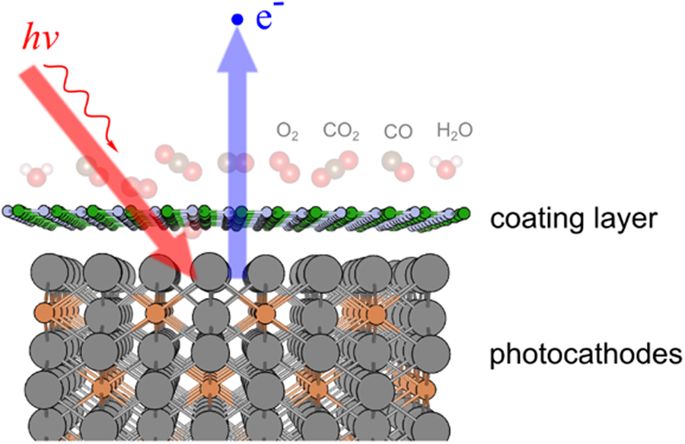npj 2D Materials and Applications ( IF 9.7 ) Pub Date : 2018-06-18 , DOI: 10.1038/s41699-018-0062-6 Gaoxue Wang , Ping Yang , Nathan A. Moody , Enrique R. Batista

|
Photocathodes are key components of electron injectors for X-ray free electron laser and X-ray energy recovery linacs, which generate brilliant, ultrafast, and coherent X-rays for the exploration of matter with ultrahigh resolutions in both space and time. Whereas alkali-based semiconducting photocathodes display a higher quantum efficiency (QE) in the visible light spectrum than their metallic counterparts, their lifetimes are much shorter due to the high reactivity of alkali-based surfaces to the residual gases in the vacuum chamber. Overcoming the tradeoff between QE and lifetimes has been a great challenge in the accelerator community. Herein, based on ab initio density functional calculations, we propose an approach to overcome this tradeoff by coating with atomically thin two-dimensional (2D) nanomaterials. On one hand, the 2D coating layers can enhance the lifetimes of photocathodes by preventing the chemical reactions with the residual gases. On the other hand, the 2D coating layers can effectively engineer the work function of photocathodes, thus controlling their QE. A monolayer of insulating BN reduces the work function, whereas a monolayer of semi-metallic graphene or semiconducting molybdenum disulfide (MoS2) increases the work function. This phenomenon originates from the induced interfacial dipoles. The reduction of work function by BN implies that it is capable of maintaining the high QE of semiconducting photocathodes in addition to enhance their lifetimes. This study advances our understandings on the surface chemistry of coated photocathodes and opens new technological avenues to fabricate photocathodes with high QE and longer lifetimes.
中文翻译:

通过涂覆原子薄的二维纳米材料来克服光电阴极的量子效率-寿命折衷
光电阴极是X射线自由电子激光和X射线能量回收直线加速器的电子注射器的关键组件,它们产生明亮,超快和相干的X射线,用于在时空上以超高分辨率探测物质。尽管基于碱的半导体光电阴极在可见光谱中比其金属同行具有更高的量子效率(QE),但由于基于碱的表面对真空室中残留气体的高反应性,因此它们的寿命要短得多。克服QE和生命周期之间的折衷一直是加速器社区中的巨大挑战。在本文中,基于从头算密度函数的计算,我们提出了一种通过涂覆原子薄的二维(2D)纳米材料来克服这种折衷的方法。一方面,2D涂层可以通过防止与残留气体的化学反应来延长光阴极的寿命。另一方面,二维涂层可以有效地设计光电阴极的功函数,从而控制其QE。单层绝缘BN会降低功函,而单层半金属石墨烯或半导体二硫化钼(MoS2)增加工作功能。这种现象起源于感应的界面偶极子。BN的功函数降低意味着它能够维持半导体光电阴极的高QE,并延长其使用寿命。这项研究提高了我们对涂层光电阴极表面化学的理解,并开辟了新的技术途径来制造具有高QE和更长寿命的光电阴极。



























 京公网安备 11010802027423号
京公网安备 11010802027423号